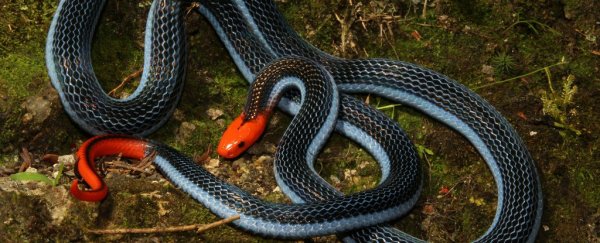While all venomous snake bites are a serious worry, most take longer than you'd expect to kill a fully grown human. That's because venom typically works by slowing down the body's vital systems until the victim drifts off to death.
But the blue coral snake (Calliophis bivirgata) is different. These beautifully coloured snakes from South East Asia and have a venom that's so powerful, it can trigger all of the victim's nerves to fire at once, instantly trigging full body spasms, paralysis, and a quick, horrifying death.
Now, researchers from Australia have fully analysed this crazy and unique venom, and the good news is they think it might lead to better pain treatments in the future.
"These snakes are 'killer's killers'. They specialise in preying on other venomous snakes, including young king cobras, so they play a 'hunt the most dangerous' game," said team member Bryan Fry, from the University of Queensland.
"With its combination of electric blue stripes and neon red head and tail, the blue coral snake is arguably one of the world's most striking species of snake. It also has the biggest venom glands in the world, extending over a quarter the length of its body."
Blue coral snakes typically grow to be about 1.8 metres in length (5.9 feet) and stay pretty thin their entire lives. The snakes' venom has caused two reported human deaths over the past century, and there's currently no anti-venom for their bite. But the good news is they generally tend to avoid humans where possible.
The reason their venom is so ridiculously potent is because the snakes love to eat animals that are also deadly, such as cobras, meaning that if they had a weaker venom that operated like other snakes' venom, they would open themselves up to the possibility of dying at every meal, which is no good when all you want is a quick dinner.
So blue coral snakes have evolved a type of venom that causes their prey to instantly freeze with muscle spasms (think: a giant cramp, but all over your body).
Paralysing their prey in this manner, much like how a spider or scorpion uses venom, allows them to take control of the situation – which is pretty important, if you spend your days hunting cobras and other venomous snakes.
"Their blazingly fast venom does not kill immediately. Instead, it turns on all the nerves of their fast-moving prey – who are also potential predators – at one time, almost instantly resulting in a frozen state," Fry said.
While previous research has shown that this is how blue coral snakes hunt, it was unclear how the venom could be so potent. So Fry and his team decided to investigate.
After analysing the chemical makeup of the venom, the team identified a new type of toxin called calliotoxin. Calliotoxin works by attacking the prey's sodium channels – the pathways that turn nerves on and off.
So the snake's venom turns these channels on and keeps them on, causing paralysis to take over the body by 'frying' the nervous system. This is the first time a snake has been shown to use this strategy – which is more similar to the venom of cone snails or scorpions.
"Some animals cause their prey's nerves to become fried by a massive shock to the system," Fry explains. "A cone snail instantly paralyses a fish into a rigid death mask, fully tensing the muscles in a tetanus-like spasm."
"This keeps the fish from escaping the immobile snail. Now it has been shown there is a snake that kills the same way."
Understanding sodium channel disruption has been a long-term pursuit of pharmaceutical researchers, because it's thought that it could hold the keys to unlocking better pain treatments for those with chronic ailments.
So now that researchers know that blue coral snakes produce a venom that affects these channels, the team hopes that their findings might lead to better pain medicine down the road.
"This venom hits a particular type of sodium channel that is important for the treatment of pain in humans," Fry said. "This is another in the long line of useful discoveries from venom that could benefit human health."
The bad news is that blue coral snakes are becoming rarer in the wild. The team reports that up to 80 percent of the snake's natural habitat has been destroyed by human development.
Hopefully, researchers can do something to save these beautiful snakes, because there are still many unknowns to be figured out, including how they could better our understanding of human health.
The team's work was published in Toxins.
